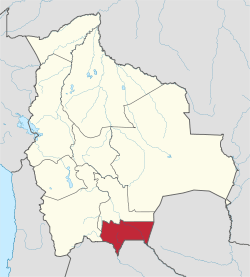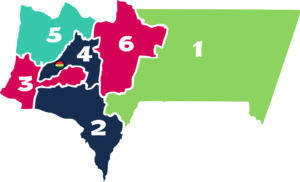Tarija Department
| Tarija Department | ||
|---|---|---|
| Department | ||
| ||
| Motto(s): ¡La Muy Leal y Muy Fiel! (The very loyal and very faithful!) | ||
| Anthem: Lyrics: Tomás O’Connor D'Arlach Music: Juan Fiori - starts with "Tarijeños la fama pregona...." | ||
 Tarija in Bolivia | ||
| Coordinates: 21°35′S 63°50′W / 21.583°S 63.833°WCoordinates: 21°35′S 63°50′W / 21.583°S 63.833°W | ||
| Country | Bolivia | |
| Capital | Tarija | |
| Government | ||
| • Governor | Mario Cossío (CC) | |
| • Senators | ||
| Area | ||
| • Total | 37,623 km2 (14,526 sq mi) | |
| • % of Bolivia | 3.42 km2 (1.32 sq mi) | |
| Population (2012) | ||
| • Total | 482,196 | |
| • Density | 13/km2 (33/sq mi) | |
| Languages (speakers) | ||
| • Spanish | 365,710 | |
| • Quechua | 37,337 | |
| • Aymara | 7,219 | |
| • Guaraní | 4,578 | |
| ISO 3166 code | BO-T | |
| Capital | Tarija | |
| Provinces | 6 | |
| Website | Department website | |
Tarija (Spanish pronunciation: [taˈɾixa]) is a department in Bolivia. It is located in south-eastern Bolivia bordering with Argentina to the south and Paraguay to the east. According to the 2012 census, it has a population of 482,196 inhabitants. It has an area of 37,623 km2 (14,526 sq mi). The city of Tarija is the capital of the department.
Subdivisions

The department is divided into five provinces and one autonomous region:
- Gran Chaco Province (autonomous region)
- Aniceto Arce Province
- José María Avilés Province
- Cercado Province
- Eustaquio Méndez Province
- Burdett O'Connor Province
Notable places in Tarija include:
- Villamontes in the department's oil-producing eastern scrubland
- Bermejo, a border town adjoining Aguas Blancas, Argentina
- Yacuiba, a border town with Argentina.
The Department of Tarija is renowned for its mild, pleasant climate, and comprises one of the country's foremost agricultural regions. Its citizens have traditionally felt close to, and conducted a lively international trade with, neighboring towns of northern Argentina. Between 1816-1898, the region was part of Argentina, and was ceded to Bolivia in exchange for Puna de Atacama.
Tarija boasts South America's second-largest natural gas reserves. Increased gas revenues and foreign direct investment in gas exploration and distribution are fueling growth and turning Tarija into Bolivia's next industrial hub. Political instability at the national level has hindered development of the reserves, as the region has chosen to align with pro-autonomy forces which aim at the devolution of considerable powers away from the central government in favor of the departments.
More than 20 different indigenous tribes, ranging in population from 20 persons up to 1500, live in the region. The Guaraní is the largest tribe.
Important battles and events related to the 1932-35 Chaco War with Paraguay took place in the department's eastern dry lands. Tarija was the home of Víctor Paz Estenssoro, leader of the 1952 Bolivian Revolution and four-time Constitutional President.
Economy
The main economic activity is the wine industry. The land and climate are ideal for grape and wine production. The city of Tarija holds an annual Festival of Wine and Cheese.
The petroleum industry is important not only for the region but also for the country as a whole, especially the gas industry which is exported to Argentina and Brazil. The autonomous region of Gran Chaco is from where most of the gas is exploited.
Languages

The languages spoken in the department are mainly Spanish, Quechua, Aymara and Guaraní. The following table shows the numbers belonging to the recognized groups of speakers. [1]
| Language | Department | Bolivia |
|---|---|---|
| Spanish | 365,710 | 6,821,626 |
| Quechua | 37,337 | 2,281,198 |
| Aymara | 7,219 | 1,525,321 |
| Guaraní | 4,578 | 62,575 |
| Another native | 2,468 | 49,432 |
| Foreign | 5,662 | 250,754 |
| Only native | 4,562 | 960,491 |
| Native and Spanish | 44,461 | 2,739,407 |
| Spanish and foreign | 322,098 | 4,115,751 |
Places of interest

References
- ↑ obd.descentralizacion.gov.bo (Spanish)
